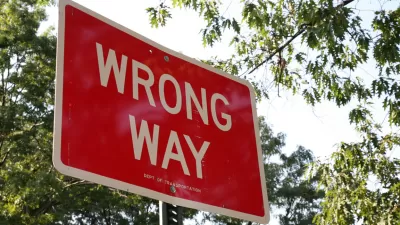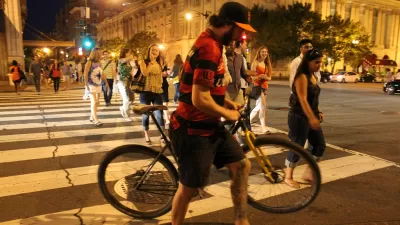The tendency of transportation planning of the 20th and 21st centuries to negatively impact poor and minority populations received deep attention on national media outlets over the past few days.

Corinne Ramey writes a long and thorough account of the inequity built into the U.S. transportation system. Ramey notes early in the article that race and transportation "have long been intertwined, whether it be federally funded highways that plowed through, or isolated, minority neighborhoods; Rosa Parks and the Montgomery Bus Boycott; or segregated streetcars and trolleys." Despite the progress made in recent decades, according to the article, discrimination is still built into the transportation system of the United States.
The article begins by citing the example of Buffalo, New York, where the Peace Bridge connecting the United States with Fort Erie in Canada. "In the shadow of the bridge sits a small neighborhood called the West Side, where the asthma rate is more than four times the national average, and residents report a host of other health issues." Rather than heading local concerns about the health impacts of the bridge, "[a] proposed expansion of the bridge’s on- and off-ramps will further encroach into the neighborhood’s streets."
But Buffalo only provides the first example of the inequity that is built into every corner of the country. Here, Ramey reveals the larger focus of the investigation: "Based on recent complaints provided by the Federal Highway Administration and Federal Transit Authority through Freedom of Information Act requests, as well as older complaints and several lawsuits, I closely examined about 40 cases of racial discrimination in transportation planning, many from the past 15 years."
The remainder of the piece delves into many examples from all over the country, with references to the prevailing scholarship on the subject.
Of note regarding the article: At some point, Slate changed the headline from a more inflammatory title "America's Transportation System Is Racist" to the current "America's Unfair Rules of the Road."
Kevin D. Williamson follows Ramey's reporting with a response in National Review. Although Williamson recommends the Slate article but pivots to describe the transportation system as "royalist" rather than racist.
FULL STORY: America’s Unfair Rules of the Road

Alabama: Trump Terminates Settlements for Black Communities Harmed By Raw Sewage
Trump deemed the landmark civil rights agreement “illegal DEI and environmental justice policy.”

Planetizen Federal Action Tracker
A weekly monitor of how Trump’s orders and actions are impacting planners and planning in America.

Why Should We Subsidize Public Transportation?
Many public transit agencies face financial stress due to rising costs, declining fare revenue, and declining subsidies. Transit advocates must provide a strong business case for increasing public transit funding.

Understanding Road Diets
An explainer from Momentum highlights the advantages of reducing vehicle lanes in favor of more bike, transit, and pedestrian infrastructure.

New California Law Regulates Warehouse Pollution
A new law tightens building and emissions regulations for large distribution warehouses to mitigate air pollution and traffic in surrounding communities.

Phoenix Announces Opening Date for Light Rail Extension
The South Central extension will connect South Phoenix to downtown and other major hubs starting on June 7.
Urban Design for Planners 1: Software Tools
This six-course series explores essential urban design concepts using open source software and equips planners with the tools they need to participate fully in the urban design process.
Planning for Universal Design
Learn the tools for implementing Universal Design in planning regulations.
Caltrans
Smith Gee Studio
Institute for Housing and Urban Development Studies (IHS)
City of Grandview
Harvard GSD Executive Education
Toledo-Lucas County Plan Commissions
Salt Lake City
NYU Wagner Graduate School of Public Service




























